steering wheel Citroen C4 AIRCROSS RHD 2012 1.G User Guide
[x] Cancel search | Manufacturer: CITROEN, Model Year: 2012, Model line: C4 AIRCROSS RHD, Model: Citroen C4 AIRCROSS RHD 2012 1.GPages: 332
Page 150 of 332
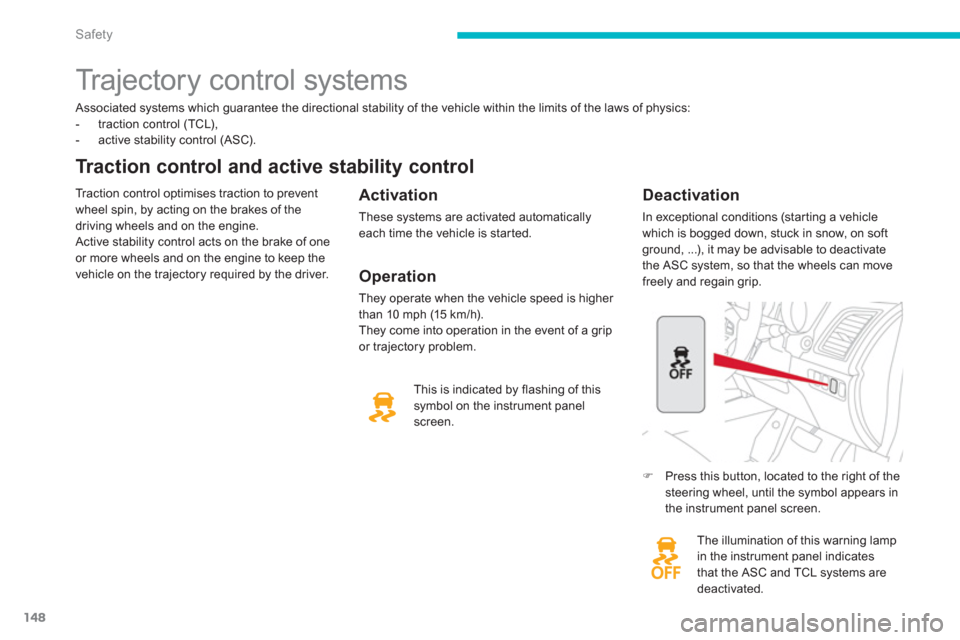
148
Safety
Associated systems which guarantee the directional stability of the vehicle within the limits of the laws of physics:
- traction control (TCL),
- active stability control (ASC).
Traction control and active stability control
Traction control optimises traction to prevent
wheel spin, by acting on the brakes of the
driving wheels and on the engine.
Active stability control acts on the brake of one
or more wheels and on the engine to keep the
vehicle on the trajectory required by the driver.
Activation
These systems are activated automaticallyeach time the vehicle is started.
The illumination o
f this warning lamp
in the instrument panel indicates
that the ASC and TCL systems are deactivated.
Deactivation
In exceptional conditions (starting a vehicle
which is bogged down, stuck in snow, on soft ground, ...), it may be advisable to deactivate
the ASC system, so that the wheels can movefreely and regain grip.
This is indicated b
y flashing of this symbol on the instrument panel screen.
Trajectory control systems
�)Press this button, located to the right of thesteering wheel, until the symbol appears in
the instrument panel screen.
Operation
They operate when the vehicle speed is higher
than 10 mph (15 km / h).
They come into operation in the event of a grip
or trajectory problem.
Page 156 of 332
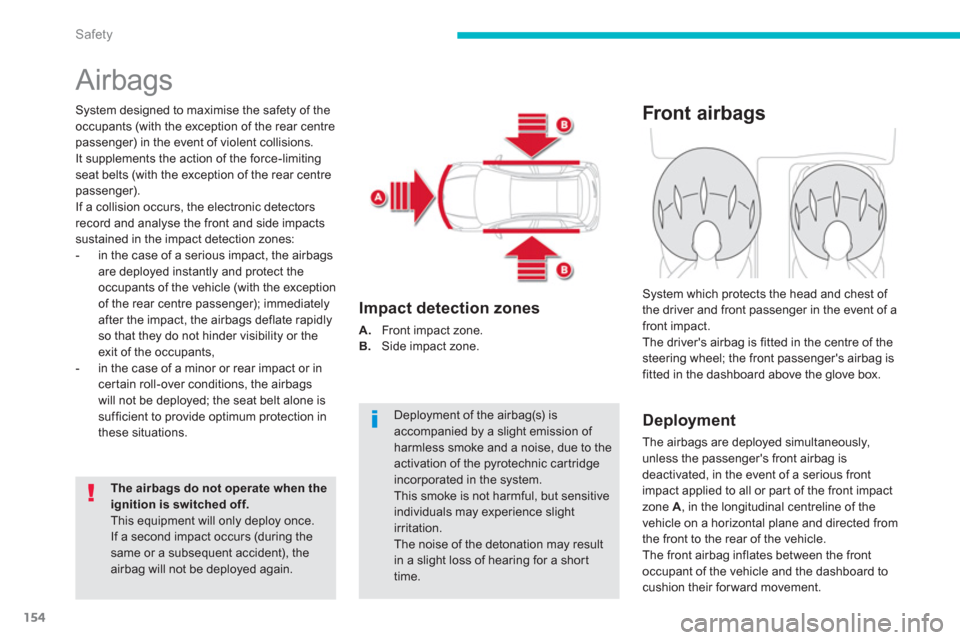
154
Safety
Airbags
System designed to maximise the safety of the
occupants (with the exception of the rear centrepassenger) in the event of violent collisions.
It supplements the action of the force-limiting seat belts (with the exception of the rear centrepassenger).
If a collision occurs, the electronic detectors record and analyse the front and side impacts sustained in the impact detection zones:
- in the case of a serious impact, the airbagsare deployed instantly and protect the
occupants of the vehicle (with the exception
of the rear centre passenger); immediately after the impact, the airbags deflate rapidlyso that they do not hinder visibility or the
exit of the occupants,
- in the case of a minor or rear impact or incer tain roll-over conditions, the airbags
will not be deployed; the seat belt alone is
sufficient to provide optimum protection in
th
ese situations.
The airbags do not operate when the ignition is switched off. This equipment will only deploy once.
If a second impact occurs (during thesame or a subsequent accident), theairbag will not be deployed again.
Deployment of the airbag(s) is accompanied by a slight emission of harmless smoke and a noise, due to theactivation of the pyrotechnic cartridgeincorporated in the system.This smoke is not harmful, but sensitiveindividuals may experience slight irritation.
The noise of the detonation may result in a slight loss of hearing for a shorttime.
Impact detection zones
A.
Front impact zone. B.
Side impact zone.
Front airbags
Deployment
The airbags are deployed simultaneously,
unless the passenger's front airbag is
deactivated, in the event of a serious front
impact applied to all or par t of the front impact
zone A , in the longitudinal centreline of the
vehicle on a horizontal plane and directed from
the front to the rear of the vehicle.
The front airbag inflates between the front
occupant of the vehicle and the dashboard to
cushion their forward movement.
System which protects the head and chest of
the driver and front passenger in the event of a
front impact.
The driver's airba
g is fitted in the centre of the steering wheel; the front passenger's airbag is
fitted in the dashboard above the glove box.
Page 160 of 332
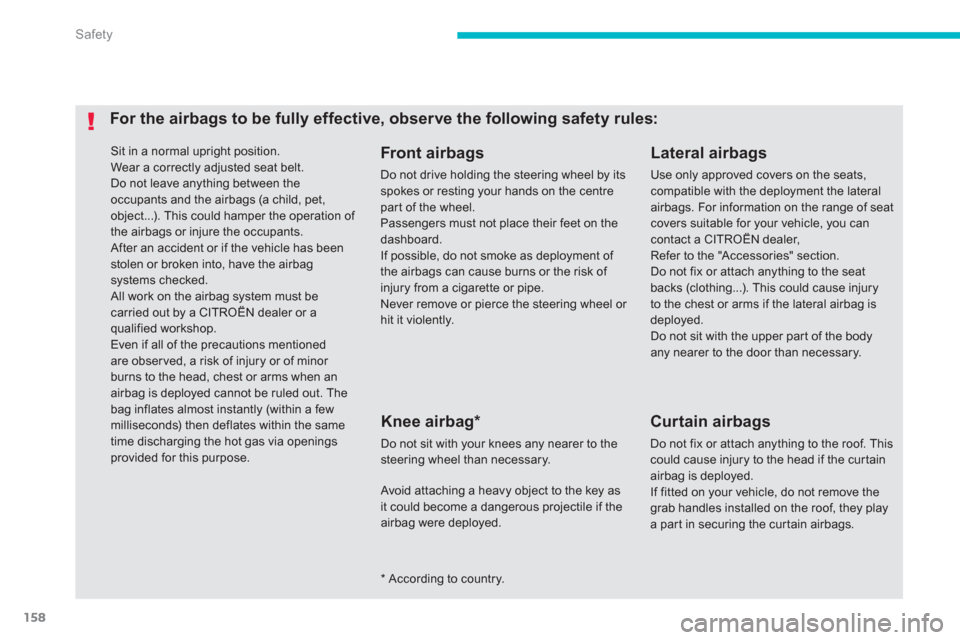
158
Safety
Sit in a normal upright position.
Wear a correctly adjusted seat belt.
Do not leave anything between theoccupants and the airbags (a child, pet,object...). This could hamper the operation of the airbags or injure the occupants. After an accident or if the vehicle has beenstolen or broken into, have the airbagsystems checked. All work on the airbag system must be carried out by a CITROËN dealer or a qualified workshop.
Even if all of the precautions mentioned are obser ved, a risk of injury or of minor burns to the head, chest or arms when an airbag is deployed cannot be ruled out. Thebag inflates almost instantly (within a few milliseconds) then deflates within the same
time discharging the hot gas via openings provided for this purpose.
Knee airbag
*
Do not sit with your knees any nearer to the steering wheel than necessary.
Front airbags
Do not drive holding the steering wheel by its spokes or resting your hands on the centre part of the wheel.
Passengers must not place their feet on thedashboard.
If possible, do not smoke as deployment of the airbags can cause burns or the risk of injury from a cigarette or pipe.
Never remove or pierce the steering wheel or hit it violently.
For the airbags to be fully effective, observe the following safety rules:
Lateral airbags
Use only approved covers on the seats, compatible with the deployment the lateral airbags. For information on the range of seatcovers suitable for your vehicle, you can contact a CITROËN dealer, Refer to the "Accessories" section.Do not fix or attach anything to the seat backs (clothing...). This could cause injuryto the chest or arms if the lateral airbag isdeployed.Do not sit with the upper par t of the body any nearer to the door than necessary.
*
According to country.
Avoid attaching a heavy object to the key asit could become a dangerous projectile if theairbag were deployed.
Curtain airbags
Do not fix or attach anything to the roof. Thiscould cause injury to the head if the cur tainairbag is deployed.
If fitted on your vehicle, do not remove the grab handles installed on the roof, they playa par t in securing the cur tain airbags.
Page 172 of 332
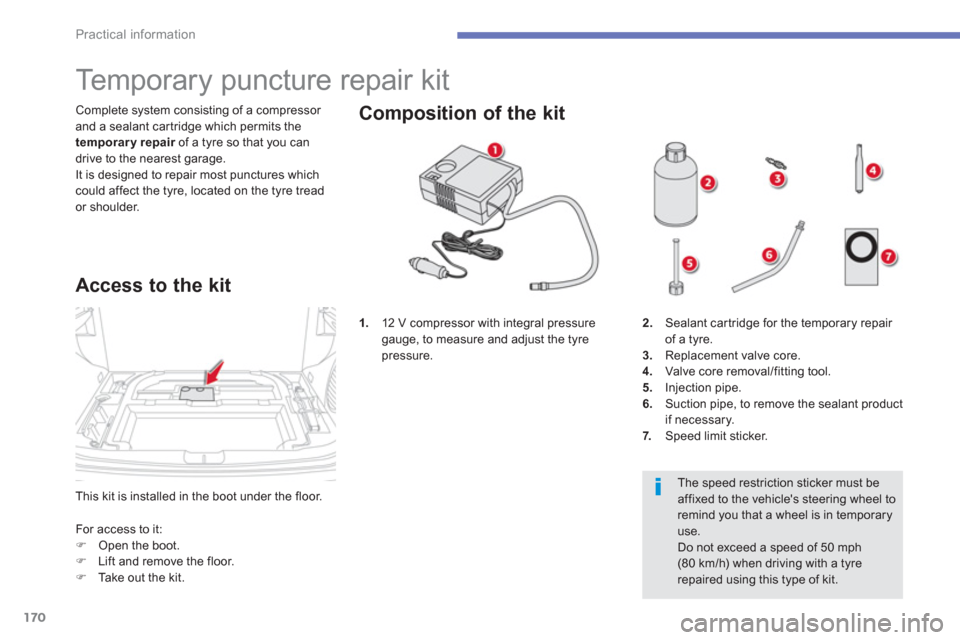
170
Practical information
This kit is installed in the boot under the floor. Complete s
ystem consisting of a compressor and a sealant car tridge which permits the
temporary repair of a tyre so that you can rdrive to the nearest garage.It is designed to repair most punctures which could affect the tyre, located on the tyre tread or shoulder.
Temporary puncture repair kit
Access to the kit
1.12 V compressor with integral pressuregauge, to measure and adjust the tyre pressure.
F
or access to it:
�)Open the boot.�)Lift and remove the floor. �)Ta k e out the kit.
Composition of the kit
The speed restriction sticker must beaffixed to the vehicle's steering wheel toremind you that a wheel is in temporaryuse.
Do not exceed a speed of 50 mph (80 km/h) when driving with a tyre repaired using this type of kit.
2.Sealant car tridge for the temporary repair
of a tyre. 3.Replacement valve core.4. Valve core removal/fitting tool.
5. Injection pipe.
6.Suction pipe, to remove the sealant product
if necessary.
7
. Speed limit sticker.
Page 173 of 332
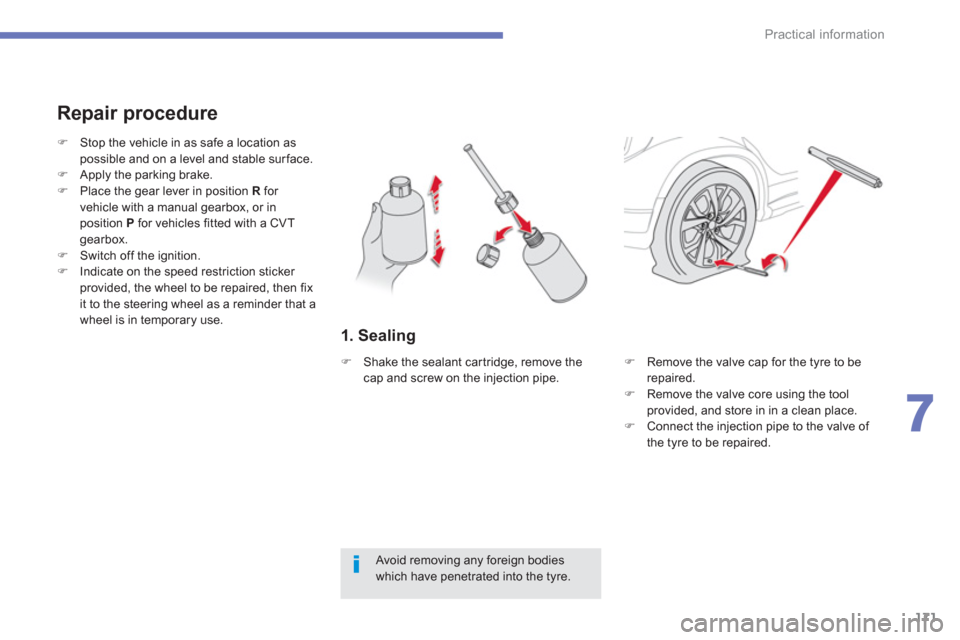
171
7
Practical information
1. Sealing
Repair procedure
Avoid removing any foreign bodies which have penetrated into the tyre.
�)Stop the vehicle in as safe a location as
possible and on a level and stable surface. �)Apply the parking brake. �)Place the gear lever in position Rfor
vehicle with a manual gearbox, or inposition P for vehicles fitted with a CVT
gearbox. �)Switch off the ignition. �)Indicate on the speed restriction sticker provided, the wheel to be repaired, then fixit to the steering wheel as a reminder that a
wheel is in temporary use.
�)
Remove the valve cap for the tyre to be
repaired. �) Remove the valve core using the toolprovided, and store in in a clean place.�)
Connect the injection pipe to the valve of
the tyre to be repaired.
�) Shake the sealant car tridge, remove thecap and screw on the injection pipe.
Page 198 of 332
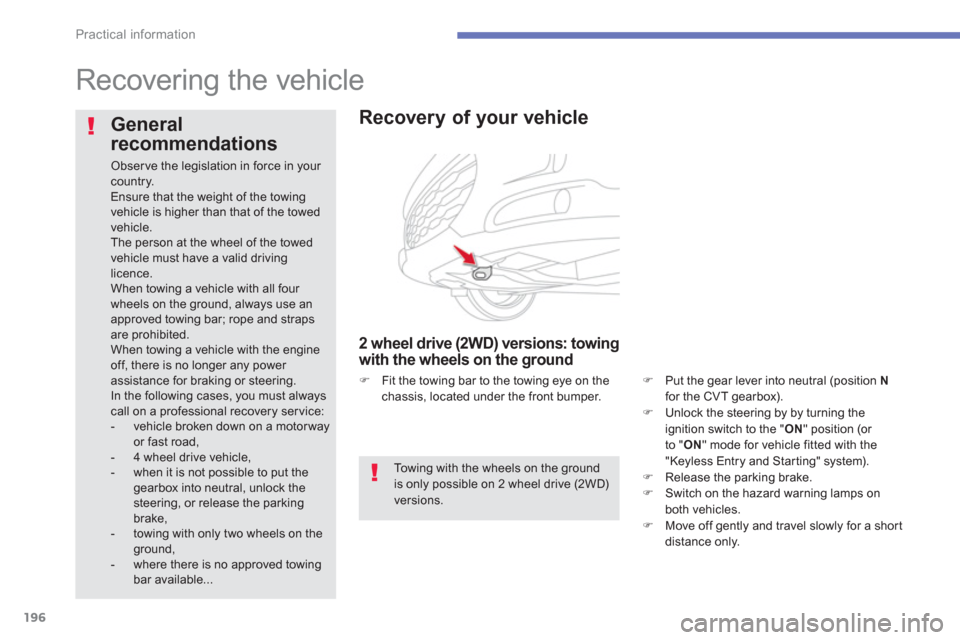
196
Practical information
Recovering the vehicle
General
recommendations
Obser ve the legislation in force in your country.
Ensure that the weight of the towing vehicle is higher than that of the towed vehicle.
The person at the wheel of the towed vehicle must have a valid drivinglicence.
When towing a vehicle with all four wheels on the ground, always use anapproved towing bar; rope and strapsare prohibited.
When towing a vehicle with the engine off, there is no longer any power assistance for braking or steering.
In the following cases, you must always call on a professional recovery service:
- vehicle broken down on a motor way or fast road,
- 4 wheel drive vehicle,
- when it is not possible to put thegearbox into neutral, unlock the steering, or release the parking brake,
- towing with only two wheels on the ground,
- where there is no approved towing bar available...
Towing with the wheels on the groundis only possible on 2 wheel drive (2WD) versions.
Recovery of your vehicle
2 wheel drive (2WD) versions: towingwith the wheels on the ground
�)Put the gear lever into neutral (position Nfor the CVT gearbox).�)Unlock the steering by by turning the
ignition switch to the " ON
" position (or
t
o " ON " mode for vehicle fitted with the
"Keyless Entry and Star ting" system). �)Release the parking brake. �)Switch on the hazard warning lamps on both vehicles.�)Move off gently and travel slowly for a shor t
distance only.
�) Fit the towing bar to the towing eye on thechassis, located under the front bumper.
Page 204 of 332
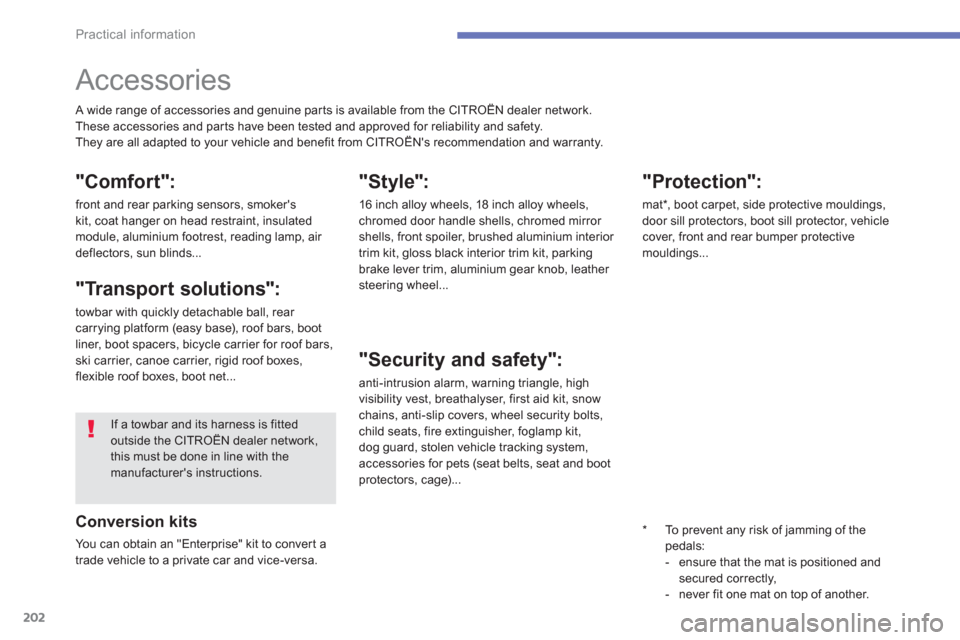
202
Practical information
Accessories
A wide range of accessories and genuine par ts is available from the CITROËN dealer network.
These accessories and par ts have been tested and approved for reliability and safety.
They are all adapted to your vehicle and benefit from CITROËN's recommendation and warranty.
"Comfort":
front and rear parking sensors, smoker'skit, coat hanger on head restraint, insulatedmodule, aluminium footrest, reading lamp, air
deflectors, sun blinds...
"Transport solutions":
towbar with quickly detachable ball, rear carrying platform (easy base), roof bars, boot
liner, boot spacers, bicycle carrier for roof bars, ski carrier, canoe carrier, rigid roof boxes, flexible roof boxes, boot net...
"Style":
16 inch alloy wheels, 18 inch alloy wheels, chromed door handle shells, chromed mirror
shells, front spoiler, brushed aluminium interior
trim kit, gloss black interior trim kit, parkingbrake lever trim, aluminium gear knob, leather
steering wheel...
"Security and safety":
anti-intrusion alarm, warning triangle, high
visibility vest, breathalyser, first aid kit, snowchains, anti-slip covers, wheel security bolts, child seats, fire extinguisher, foglamp kit, dog guard, stolen vehicle tracking system,
accessories for pets (seat belts, seat and boot
protectors, cage)...
"Protection":
mat *
, boot carpet, side protective mouldings, door sill protectors, boot sill protector, vehiclecover, front and rear bumper protectivemouldings...
Conversion kits
You can obtain an "Enterprise" kit to conver t a
trade vehicle to a private car and vice-versa.
If a towbar and its harness is fitted outside the CITROËN dealer network, this must be done in line with themanufacturer's instructions.
*
To prevent any risk of jamming of thepedals:
- ensure that the mat is positioned and
secured correctly,
- never fit one mat on top of another.
Page 323 of 332
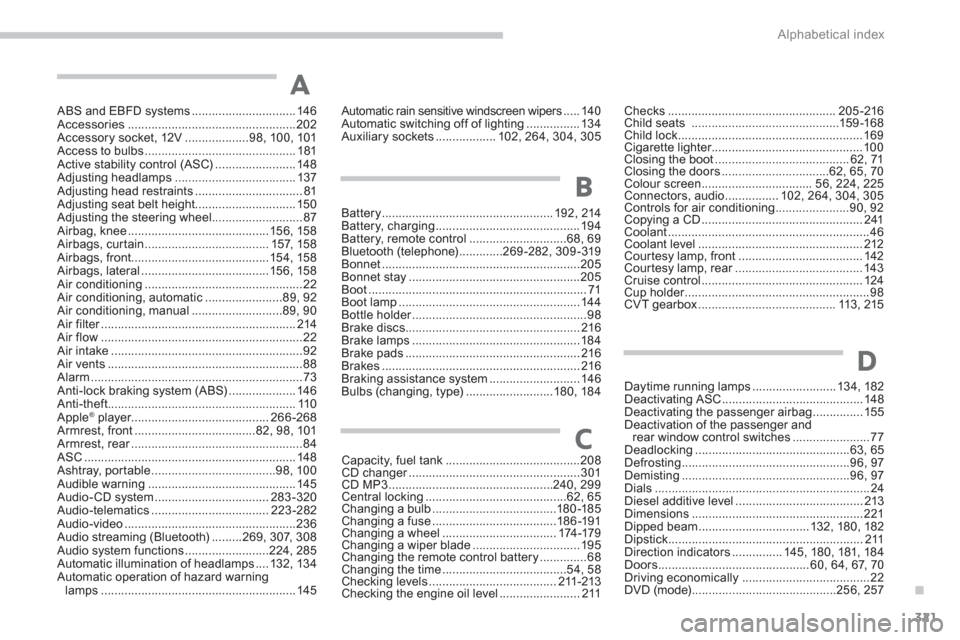
.
321 Alphabetical index
ABS and EBFD systems ...............................146Accessories..................................................202Accessory socket, 12V ...................98, 100,101Access to bulbs.............................................181Active stability control (ASC)........................148Adjusting headlamps....................................137Adjusting head restraints ................................81Adjusting seat belt height..............................150Adjusting the steering wheel ...........................87Airbag, knee.......................................... 156, 158Airbags, curtain.....................................157,158Airbags, front......................................... 154, 158Airbags, lateral......................................156,158Air conditioning...............................................22Air conditioning, automatic.......................89, 92Air conditioning, manual ...........................89,90Air filter..........................................................r214Air flow............................................................22Air intake.........................................................92Air vents ..........................................................88Alarm...............................................................73Anti-lock braking system (ABS)....................146Anti-theft........................................................110Apple® player®.........................................266-268Armrest, front....................................82,98,101Armrest, rear...................................................r84ASC............................................................... 148Ashtray, por table.....................................98,100Audible warning ............................................ 145Audio-CD system..................................283-320Audio-telematics...................................223-282Audio-video...................................................236Audio streaming (Bluetooth).........269,307,308Audio system functions.........................224, 285Automatic illumination of headlamps ....132,134Automatic operation of hazard warninglamps..........................................................145
Automatic rain sensitive windscreen wipers .....140Automatic switching off of lighting ................134Auxiliary sockets..................102, 264,304,305
Capacity, fuel tank ........................................208CD changer...................................................r301CD MP3.................................................240, 299Central locking..........................................62,65Changing a bulb.....................................180-185Changing a fuse.....................................186-191Changing a wheel..................................174-179Changing a wiper blade................................195Changing the remote control battery..............68Changing the time.....................................54, 58Checking levels......................................211-213Checking the engine oil level........................211
A
C
Checks ..................................................205-216Child seats ............................................159-168Child lock.......................................................169Cigarette lighter.............................................r100Closing the boot........................................62, 71Closing the doors................................62,65, 70Colour screen .................................56, 224, 225Connectors, audio................102,264,304, 305Controls for air conditioning......................90, 92Copying a CD ................................................241Coolant............................................................46Coolant level.................................................212Courtesy lamp, front.....................................142Cour tesy lamp, rear......................................r143Cruise control................................................124Cup holder.......................................................r98CVT gearbox.........................................113,215
Battery ...................................................192,214
Battery, charging...........................................194Battery, remote control.............................68,69Bluetooth (telephone).............269-282, 309-319Bonnet...........................................................205Bonnet stay...................................................205Boot .................................................................71Boot lamp......................................................144Bottle holder....................................................r98Brake discs....................................................216Brake lamps ..................................................184Brake pads....................................................216Brakes...........................................................216Braking assistance system...........................146Bulbs (changing, type) ..........................180, 184
B
Daytime running lamps.........................134,182Deactivating ASC ..........................................148Deactivating the passenger airbag...............155Deactivation of the passenger and
rear window control switches .......................77Deadlocking ..............................................63, 65Defrosting..................................................96, 97Demisting..................................................96, 97Dials................................................................24Diesel additive level ......................................213Dimensions ...................................................221Dipped beam.................................132, 180,182Dipstick..........................................................211Direction indicators ...............145, 180,181, 184Doors .............................................60, 64, 67, 70Driving economically ......................................22DVD (mode)...........................................256,257
D
Page 324 of 332
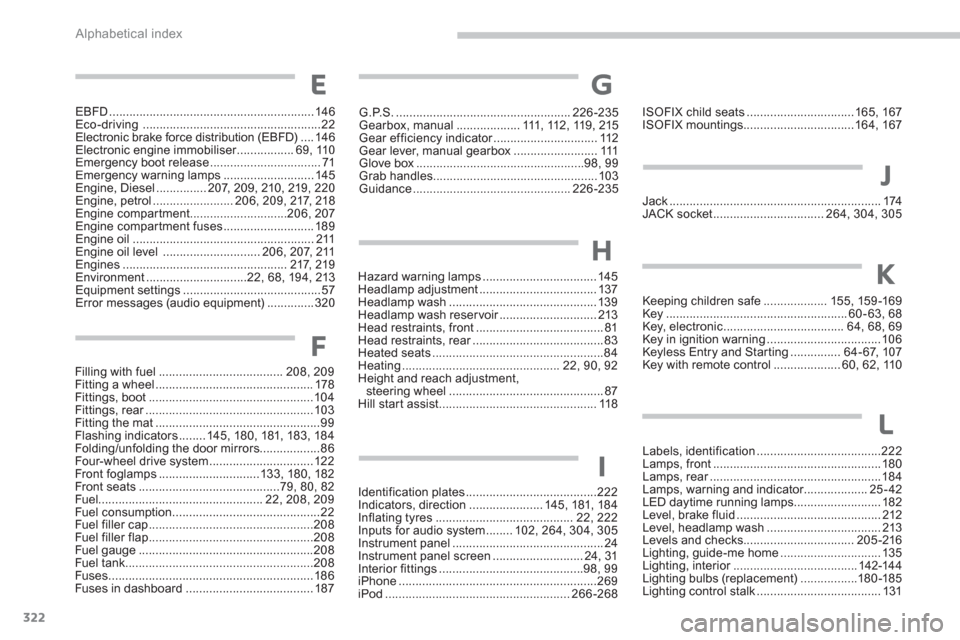
322
Alphabetical index
EBFD .............................................................146Eco-driving .....................................................22Electronic brake force distribution (EBFD)....146Electronic engine immobiliser.................r69, 110Emergency boot release .................................71Emergency warning lamps ........................... 145Engine, Diesel...............207, 209, 210, 219,220Engine, petrol........................206, 209, 217,218Engine compartment .............................206, 207Engine compar tment fuses ...........................189Engine oil ...................................................... 211Engine oil level .............................206, 207, 211Engines.................................................217, 219Environment..............................22, 68, 194, 213Equipment settings .........................................57Error messages (audio equipment)..............320
G.P.S.....................................................226-235Gearbox, manual...................111, 112,119, 215Gear efficiency indicator...............................r112Gear lever, manual gearbox.........................111Glove box..................................................98, 99Grab handles.................................................103Guidance ...............................................226-235Jack ...............................................................174JACK socket .................................264,304,305
ISOFIX child seats................................165, 167ISOFIX mountings.................................164, 167
Keeping children safe ...................155, 159 -169Key ......................................................60-63, 68Key, electronic ....................................64, 68, 69Key in ignition warning..................................106Keyless Entry and Star ting...............64-67, 107Key with remote control ....................60, 62, 110
G
J
K
Filling with fuel .....................................208,209Fitting a wheel...............................................178Fittings, boot.................................................104Fittings, rear..................................................r103Fitting the mat.................................................99Flashing indicators ........145, 180,181,183, 184Folding/unfolding the door mirrors..................86Four-wheel drive system...............................122Front foglamps ..............................133, 180,182Front seats..........................................79, 80, 82Fuel.................................................22, 208,209Fuel consumption............................................22Fuel filler cap.................................................208Fuel filler flap .................................................208Fuel gauge....................................................208Fuel tank........................................................208Fuses.............................................................186Fuses in dashboard ......................................187
F
Hazard warning lamps .................................. 145Headlamp adjustment...................................137Headlamp wash............................................139Headlamp wash reser voir.............................r213Head restraints, front ......................................81Head restraints, rear.......................................r83Heated seats...................................................84Heating ...............................................22,90,92Height and reach adjustment,
steering wheel ..............................................87Hill start assist...............................................118
H
Labels, identification.....................................222Lamps, front..................................................180Lamps, rear...................................................r184Lamps, warning and indicator...................r25-42LED daytime running lamps..........................182Level, brake fluid...........................................212Level, headlamp wash..................................213Levels and checks................................. 205 -216Lighting, guide-me home..............................135Lighting, interior.....................................r142-144Lighting bulbs (replacement) .................180-185Lighting control stalk.....................................131
L
Identification plates.......................................222Indicators, direction......................145, 181, 184
Inflating tyres .........................................22, 222Inputs for audio system ........ 102, 264,304,305Instrument panel.............................................24Instrument panel screen...........................24, 31Interior fittings...........................................98, 99iPhone...........................................................269iPod.......................................................266-268
I
E
Page 329 of 332
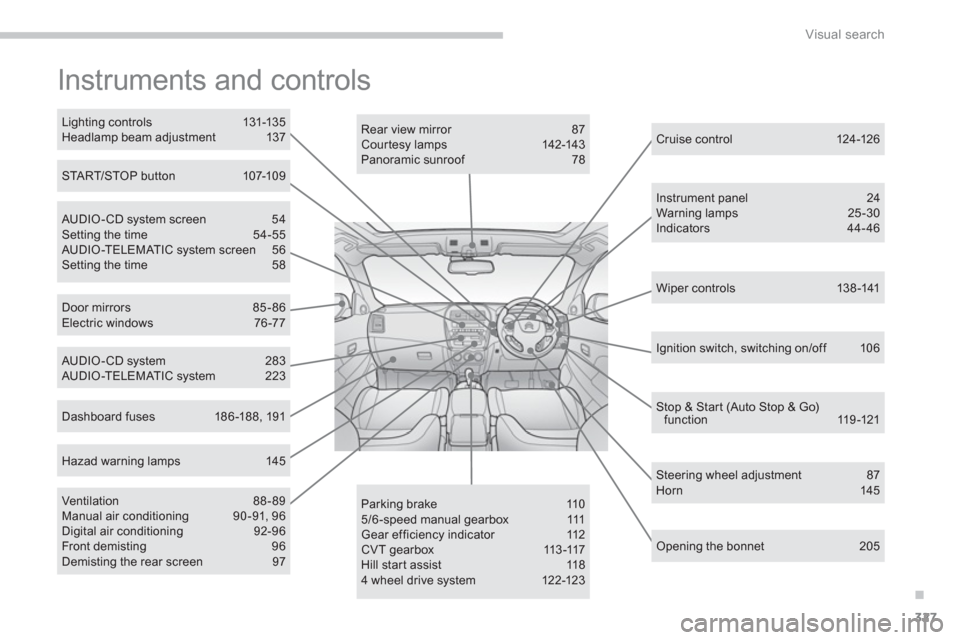
.
327
Visual search
Instruments and controls
Opening the bonnet 205
Lighting controls 131-135Headlamp beam adjustment 137
Door mirrors 85-86Electric windows 76 -77
Rear view mirror 87 Cour tesy lamps 142-143 Panoramic sunroof 78
Dashboard fuses 18 6 -188, 191
Instrument panel 24 Warning lamps 25 -30 Indicators 44-46
Cruise control 124-126
AUDIO-CD system screen 54Setting the time 54-55 AUDIO-TELEMATIC system screen 56Setting the time 58
Steering wheel adjustment 87 Horn 145
Wiper controls 138-141
Parking brake 110 5/6 -speed manual ge a r b o x 111 Gear efficiency indicator 112 CVT ge a r b o x 113 -117Hill start assist 11 8 4 wheel drive system 12 2-123
Stop & Start (Auto Stop & Go) function 119-121
AUDIO-CD system 283 AUDIO-TELEMATIC system 223
Ventilation 88- 89 Manual air conditioning 90-91, 96Digital air conditioning 92-96Front demisting 96Demisting the rear screen 97
Hazad warning lamps 145
Ignition switch, switching on/off 106
START/STOP but ton 107-109